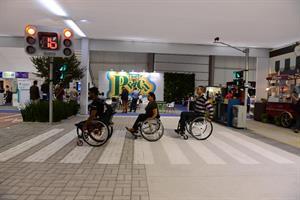Publicado em 30 de junho de 2017
Statute of the Pedestrian will improve people’s mobility

The draft foresees the generation of mechanisms to create funds that could make feasible and qualify the infrastructure available for those who are walking. These resources would come from urban operations, concessions and the Fundurb (Fund of Urban Development). According to the Directive Plan, it is limited to 30 percent of fund resources and it is designed for actions related to mobility.
One of the phases of the Statute of the Pedestrian will be the creation of an information system that will cover the regular flows carried out by those who are walking in the city. This system will gather statistic data about circulation, accidents, car hits, improvements in signaling, priority for pedestrians in crossings and bus stops and improvement in the pedestrian safety, to allow the development of mobility practices.
In the Week of Integrated Technologies for Construction, Environment and Equipment, the project Ruas Completas (Complete Routes) was presented as part of the program VivaCidade, anticipating certain concepts proposed by the Statute. The urban area—with more than 400 sq.mt.—was designed matching concepts of universal accessibility. It is an example that a harmonious coexistence between pedestrians, bicycle riders, buses and cars may be achieved. The initiative comes from the Sindicato Nacional das Empresas de Arquitetura e Engenharia Consultiva (Sinaenco – Union of Architecture and Consulting Engineering Companies) in partnership with Sobratema, National Front of Mayors and WRI Brasil.
The project included road paving, public lighting, vertical and horizontal signaling, rainwater draining system and comfortable sidewalks, in a way to ensure mobility and accessibility and to encourage the non-motorized moving and the occupation of the urban space by the citizen. At the end of the street was built a “square” that worked as a main space of coexistence, equipped with urban equipment that allows the access and full use for handicapped people.

Av. Francisco Matarazzo, 404 Cj. 701/703 Água Branca - CEP 05001-000 São Paulo/SP
Telefone (11) 3662-4159
© Sobratema. A reprodução do conteúdo total ou parcial é autorizada, desde que citada a fonte. Política de privacidade


